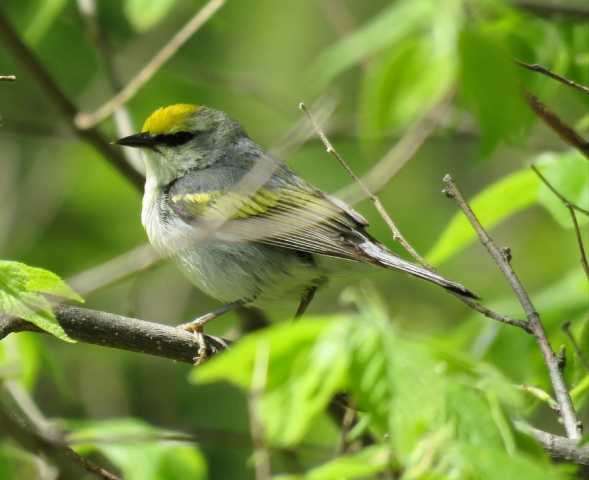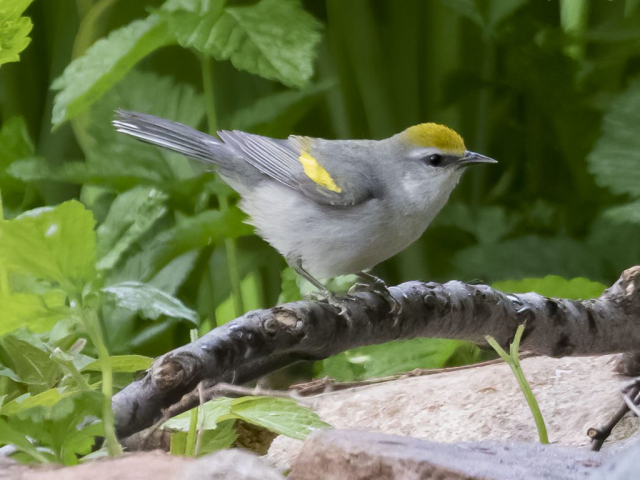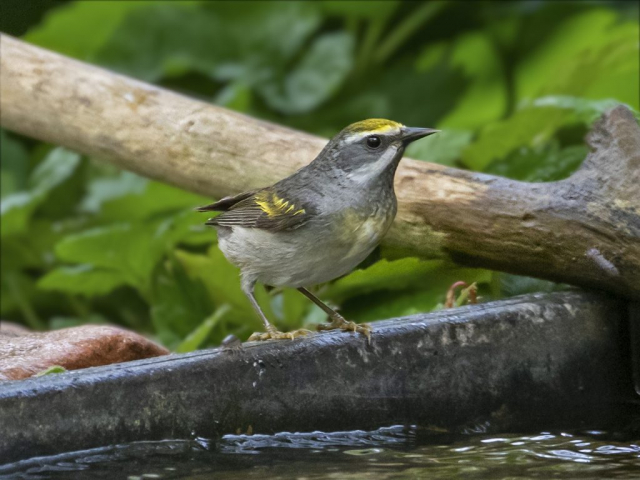Vermivora chrysoptera x VERMIVORA cyanoptera
Status: Rare casual spring and fall migrant east.
Documentation: Brewster’s Warbler: photograph, 18 May 2020 Madison Co (Brogie, in gallery).
Taxonomy: This species and Blue-winged Warbler V. cyanoptera hybridize frequently and produce fertile hybrids; their genomes are 99.97% identical, with plumage genes accounting for the difference (Toews et al 2016). The genetic basis of this hybridization was described by Confer et al (2020) and appears to be a simple Mendelian system whereby the black transocular line and plain throat and white underparts of cyanoptera are dominant and the black auricular and throat and yellow underparts of chrysoptera are recessive. Brewster’s Warbler is the F1 hybrid between the two parent species and exhibits the black transocular line and pale throat and underparts of cyanea that are inherited together. Brewster’s Warbler, according to Mendelian genetics, has both dominant Blue-winged Warbler genes and recessive Golden-winged Warber genes (black auricular and throat and yellow underparts), but the latter are not expressed in Brewster’s F1 hybrids. Lawrence’s Warbler results either from an F2 mating of two Brewster’s Warblers (such matings are rare in the field), or, most commonly, an F2 backcross between a Brewster’s Warbler and a Golden-winged Warbler; Lawrence’s exhibits the Mendelian recessive gene combination of the black auricular and throat and yellow underparts of chrysoptera. Brewster’s Warbler is much more common than Lawrence’s Warbler, as predicted by Mendelian inheritance.
See Comments for discussion of potential introgressants among Nebraska records.
Genetic studies indicate introgression of cyanoptera (Blue-winged) haplotypes into chrysoptera (Golden-winged) phenotypes with no reverse movement (Confer et al 2020), indicating that chrysoptera is being replaced by cyanoptera (Confer et al 2020). The only known remaining phenotypically and genetically pure populations of chrysoptera breed in Manitoba, where numbers are actually increasing (Confer et al 2020), possibly explaining increasing numbers being reported in Nebraska in the last few years.
Rather startling was a hybrid between a male Chestnut-sided Warbler and a Brewster’s Warbler found in Pennsylvania 7 May 2018, known as the “Burket Triple Hybrid”; it sang a Chestnut-sided Warbler song, as expected since DNA determined the genetic makeup and found that the male parent was a Chestnut-sided (Grove 2019).
Records: There are six Nebraska records of Brewster’s Warbler, four in spring and two in fall. The spring records are rather late in the migration window; hybrids often follow different migration routes and timing than their parent species.
18 May 2020 Madison Co (Mark Brogie, personal communication, photo eBird.org)
19 May 1982 Keya Paha Co (Brogie and Mossman 1983)
21 May 2020 Sarpy Co (Phil Swanson, photo in gallery)
22 May 2022 Sarpy Co (Phil Swanson, personal communication, photographs)
6 Sep 2007 Fontenelle Forest, Sarpy Co
13 Sep 2008 Oak Grove WMA, Seward Co.
Comments: Lawrence’s Warbler is extremely rare on the Great Plains, with perhaps three records, Jun and Oct in North Dakota and May in northwestern Missouri (eBird.org, accessed May 2025). An individual photographed by Phil Swanson 25 May 2021 (see bottom two photos herein) exhibited a facial pattern reminiscent of Golden-winged Warbler but without black markings and with underparts mottled in gray and yellow; although it was initially thought to be a Lawrence’s, experts have indicated it is a backcross between an F1 hybrid (Brewster’s) and an F2 introgressant (Tom Stephenson, personal communication) or a “lightly introgressed Golden-winged female, since it lacks a fully yellow nape, breast, belly” required for Lawrence’s (John McKay). McKay makes the further point that “mixed genetics Golden-winged are not the same as Lawrence’s”.
It should be added that the photographs herein by Mark Brogie (top two) of a Brewster’s Warbler do show some upper breast markings suggestive of introgression rather than what might be expected of a “pure” F1 hybrid.
Hover mouse over photos below for captions.
Acknowledgements: Photographs (top two; Mark Brogie; middle two Phil Swanson; bottom two Phil Swanson) of apparent F2 backcrosses between Brewster’s Warbler and Blue-winged or Golden-winged Warbler (See Comments).
Literature Cited:
Confer, J.L., P. Hartman, and A. Roth. 2020. Golden-winged Warbler (Vermivora chrysoptera), version 1.0. In Birds of the World (A. F. Poole, Editor). Cornell Lab of Ornithology, Ithaca, NY, USA. https://doi.org/10.2173/bow.gowwar.01.
Grove, D.S. 2019. The Identification of the Burket Triple Hybrid- a Brewster’s/Chestnut-sided Warbler. Pennsylvania Birds 33: 223-225.
Toews, D.P.L., S.A. Taylor, R. Vallender, A. Brelsford, B.G. Butcher, P.W. Messer, and I.J. Lovette. 2016. Plumage Genes and Little Else Distinguish the Genomes of Hybridizing Warblers. Current Biology 26: 2313-2318.
Recommended Citation
Silcock, W.R., and J.G. Jorgensen. 2025. Golden-winged x Blue-winged Warbler (hybrid) (Vermivora chrysoptera x cyanoptera). In Birds of Nebraska — Online. www.BirdsofNebraska.org
Updated 2 May 2025





